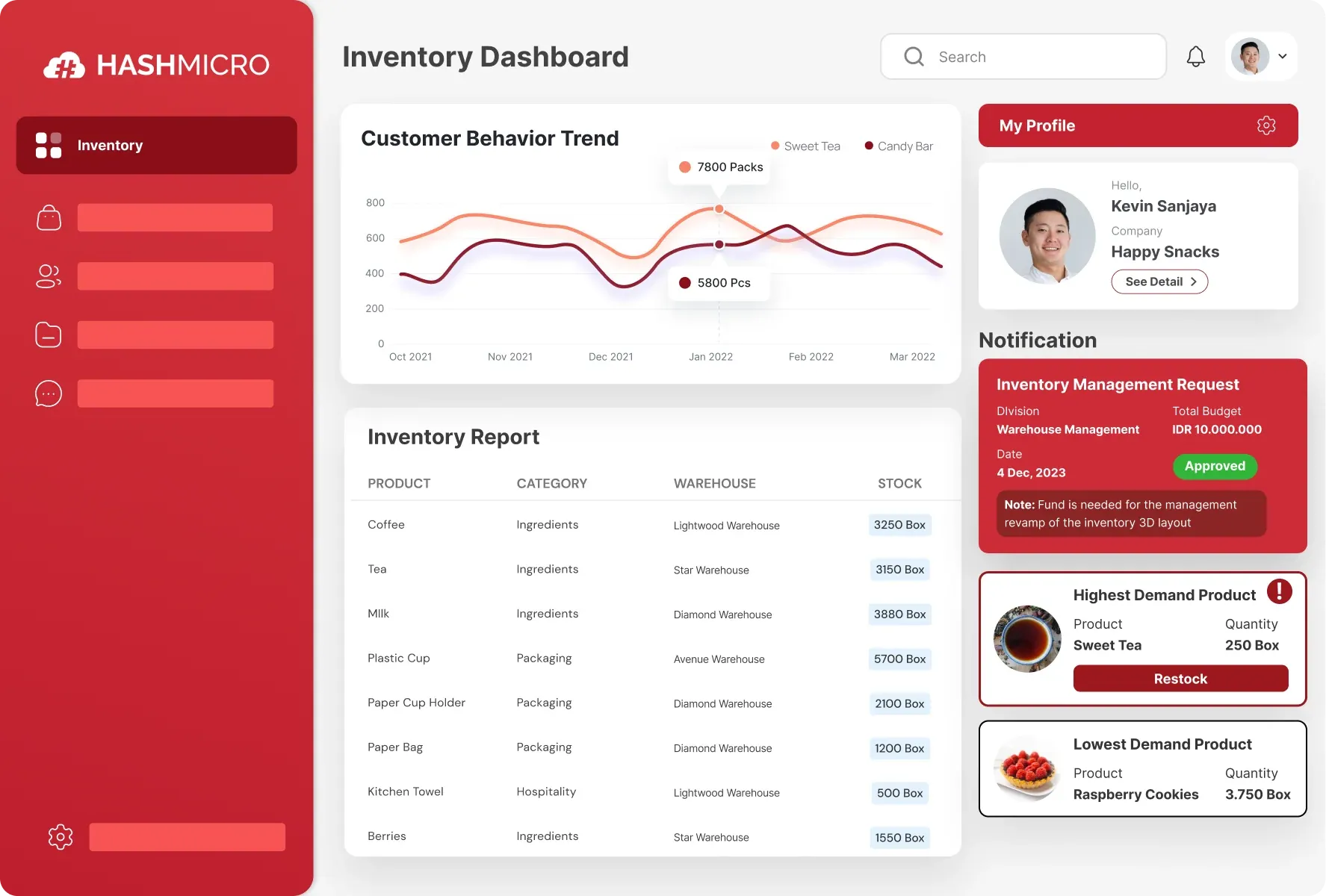If you’re not tracking your inventory KPIs, you’re running your business with a blindfold on. It’s not just about counting what’s in stock. Rather, it’s about understanding the numbers that quietly make or break your margins. Inventory management KPIs help you adjust to demand shifts and stay in control of every unit moving in or out.
Most businesses don’t realize they’re losing money on inventory until it’s too late. Expired items, missed sales, or overstocked shelves that collect dust. The right KPIs show where the gaps are and what actions to take, from sales trends to supplier performance.
Tracking these metrics becomes much easier with a system built to do it for you. This article will walk you through essential inventory KPIs, how to measure them, and how the right tools can help you track them effortlessly.
Key Takeaways
|
Table of Contents

What is Inventory Management KPI?
Key performance indicators (KPIs) in inventory management are essential metrics used to monitor stock levels and guide decision-making. They provide insights into turnover rates, sales performance, demand trends, cost efficiency, operational effectiveness, and supplier relationships.
However, there are numerous KPIs that a company must track. In order to make it a job well done, inventory management software makes it simple to track these KPIs. They help identify progress, highlight successful areas, and pinpoint processes that need improvement.
Inventory Metrics: Sales KPIs
Sales metrics can give your team a competitive edge and support collaboration and deal-closing efforts.
1. Inventory Turnover Rate
Also called inventory turn or turnover ratio, this metric shows how often a business sells and replenishes its stock within a set timeframe, typically one year. It helps assess whether inventory levels are aligned with actual sales activity. The formula is:
Inventory turnover rate = Cost of Goods Sold ÷ Average Inventory
2. Days on Hand (DOH)
Also known as Days Sales of Inventory (DSI) or the average age of inventory, this metric measures how long inventory remains unsold, expressed in days. It’s commonly used to analyze short-term performance. Use this formula:
Days on Hand = (Average Inventory ÷ Cost of Sales) × 365
3. Weeks on Hand
This metric reflects how many weeks it takes, on average, to sell through inventory. A higher number indicates slower movement, while a lower number shows faster turnover. Formula:
Weeks on Hand = (Average Inventory ÷ Cost of Sales) × 52
4. Stock-to-Sales Ratio
This shows how much inventory is held in relation to sales volume. It’s useful for evaluating whether you’re carrying excess stock that might reduce profitability. Here’s the formula:
Stock-to-Sales Ratio = Inventory Value ÷ Sales Value
5. Sell-Through Rate
This compares the number of items sold to the number received from suppliers or manufacturers, helping to evaluate how well inventory moves through the supply chain. Calculate it with:
Sell-Through Rate = (Units Sold ÷ Units Received) × 100
6. Backorder Rate
This metric tracks the percentage of customer orders that couldn’t be fulfilled due to items being out of stock. It reflects how well a business keeps up with demand for its products. To calculate backorder rate:
Backorder Rate = (Delayed Orders Due to Backorders ÷ Total Orders Placed) × 100
7. Forecast Accuracy
Also known as demand forecast accuracy, this measures how closely actual inventory levels matched the forecasted amounts. It evaluates how precise your predictions were based on past sales and ordering. Formula:
Forecast Accuracy = [(Actual – Forecast) ÷ Actual] × 100
8. Rate of Return (RoR)
Often called return on investment (ROI), this percentage shows the gain or loss on an investment relative to its original cost. It’s usually measured annually. Here’s the formula:
Rate of Return = [(Final Value – Initial Value) ÷ Initial Value] × 100
9. Product Sales
Also referred to as sales revenue, this metric represents total income from sold products, after subtracting returns, discounts, and allowances. Use this formula:
Product Sales = Gross Sales Revenue – Sales Returns – Discounts – Allowances
10. Revenue per Unit
This metric shows how much income is earned from each unit sold. It’s especially useful for subscription-based or volume-driven businesses. Calculate it with:
Revenue per Unit = Total Revenue for the Period ÷ Average Units Sold in the Period
11. Cost per Unit
Cost per unit represents how much it costs to produce or acquire one unit of a product. This is ideal for businesses with high production volume. Formula:
Cost per Unit = (Fixed Costs + Variable Costs) ÷ Number of Units Produced
12. Gross Margin by Product
Gross margin tells you how much profit is made per sale after deducting the cost of goods sold. It reflects how efficiently a product generates income. Use this formula:
Gross Margin = [(Net Sales – Cost of Goods Sold) ÷ Net Sales] × 100
13. Gross Margin Return on Investment (GMROI)
GMROI shows the return earned on inventory investments. It helps assess whether your inventory spending leads to strong profit returns. Calculate it with:
GMROI = Gross Margin ÷ Average Inventory Cost
Read more: Pharmacy Inventory Management System
Inventory Metrics: Receiving KPIs

1. Time to Receive
This metric tracks how long it takes staff to process incoming inventory—from the moment stock arrives to when it’s ready for storage or sale. It helps evaluate the speed and efficiency of your receiving operations. Formula:
Time to Receive = Time for Stock Validation + Time to Record Inventory + Time to Prepare for Storage
2. Put Away Time
Put away time measures how quickly received goods are stored in their proper locations. It begins after stock has been validated and recorded. Improving this KPI helps reduce lead time and streamline warehouse flow. Formula:
Put Away Time = Total Time to Store Received Inventory
3. Supplier Quality Index (SQI)
SQI evaluates vendor performance across several critical areas, including product quality, responsiveness, and delivery reliability. It combines weighted scores to provide a comprehensive rating of each supplier. Typically tracked monthly and averaged annually. Example formula:
Supplier Quality Index = (Material Quality × 45%) + (Corrective Action × 10%) + (Prompt Reply × 10%) + (Delivery Quality × 20%) + (Quality Systems × 5%) + (Commercial Posture × 10%)
Inventory Metrics: Operational KPIs
Operational KPIs help measure how smoothly your business runs on a day-to-day basis. Strong internal performance in these areas often translates to better customer satisfaction and overall efficiency.
1. Lost Sales Ratio
This KPI tracks the percentage of the year a product is out of stock compared to its expected sales activity. A high ratio may indicate that inventory levels are too low, leading to missed sales opportunities. Formula:
Lost Sales Ratio = (Days Out of Stock ÷ 365) × 100
2. Perfect Order Rate
This measures how many orders are shipped without errors—on time, complete, damage-free, and with correct documentation. A high perfect order rate indicates strong operational accuracy and customer satisfaction. Use this formula:
Perfect Order Rate = [(On-Time Deliveries ÷ Total Orders) × (Complete Orders ÷ Total Orders) × (Damage-Free Orders ÷ Total Orders) × (Accurate Documentation ÷ Total Orders)] × 100
3. Inventory Shrinkage
This metric reflects the gap between recorded inventory and what’s physically in stock. Shrinkage is often due to theft, damage, or errors, and it can impact profitability. Formula:
Inventory Shrinkage = Ending Inventory Value – Physically Counted Inventory Value
4. Average Inventory
Average inventory calculates the typical amount of stock a business holds over a given period. Maintaining a consistent level helps with planning and avoids overstocking or shortages. Use this formula:
Average Inventory = (Beginning Inventory + Ending Inventory) ÷ 2
5. Inventory Carrying Cost
Also known as holding cost, this metric shows the percentage of inventory value spent on storing products. It includes expenses like warehousing, insurance, labor, and losses from unsellable stock. The total cost varies depending on product type, number of SKUs, storage setup, and turnover rate. Formula:
Inventory Carrying Cost = [(Service Costs + Risk Costs + Capital Cost + Storage Cost) ÷ Total Inventory Value] × 100
6. Customer Satisfaction Score (CSAT)
CSAT measures how satisfied customers are with your product or service, usually gathered through short post-purchase surveys. A higher score reflects better customer experience. Formula:
Customer Satisfaction Score = (Positive Responses ÷ Total Responses) × 100
7. Fill Rate
Also called line fill rate, this KPI tracks the percentage of customer orders that are fully fulfilled. It’s used to evaluate performance across the entire supply chain. Formula:
Fill Rate = [(Total Items – Unshipped Items) ÷ Total Items] × 100
8. Gross Margin Percent
This shows how much profit remains after subtracting the cost of goods sold from revenue. It’s a key indicator of pricing strategy and cost efficiency. Formula:
Gross Margin Percent = [(Total Revenue – Cost of Goods Sold) ÷ Total Revenue] × 100
9. Order Cycle Time
Also called order timeliness, this measures how long it takes to complete a customer order from placement to delivery. Shorter cycles typically indicate higher operational efficiency. Formula:
Order Cycle Time = (Time Order Was Received – Time Order Was Placed) ÷ Total Shipped Orders
10. Stock-Outs
This KPI reflects how often items are unavailable when customers try to order them. Frequent stock-outs can lead to lost sales and reduced customer trust. Use this formula:
Stock-Outs = (Items Out of Stock ÷ Items Shipped) × 100
11. Lead Time
Lead time tracks how long it takes from the moment a customer places an order until they receive the product. It reflects the overall responsiveness of your supply chain. To calculate:
Lead Time = Order Processing Time + Production Time + Delivery Time
12. Dead Stock / Spoilage
Dead stock refers to unsold items that can no longer be sold, often due to low demand or being outdated. Spoilage is similar but applies to perishable goods like food. High percentages of dead or spoiled stock can signal serious inventory issues.
Set clear criteria for what qualifies as “unsellable” (e.g., after a season ends). Use this formula:
Dead/Spoiled Stock = (Unsellable Stock During Period ÷ Total Available Stock During Period) × 100
Inventory Metrics: Employee KPIs
Employee KPIs, or labor KPIs, measure how effectively your workforce contributes to business output. They reveal whether your team is working efficiently, contributing to production goals, and generating value for the company.
1. Labor Cost per Item
Also called unit labor cost, this KPI shows how much labor expense goes into producing a single unit. It includes wages and any labor-related costs tied to moving the product through production to sale. Formula:
Labor Cost per Item = Total Labor Expense ÷ Total Units Produced
2. Labor Cost per Hour
This measures how much each working hour costs the company per employee. It’s useful for evaluating the cost-effectiveness of meetings, tasks, or time allocation. Formula:
Labor Cost per Hour = (Annual Gross Salary ÷ Weeks Worked per Year) ÷ Hours Worked per Week
How to Measure KPI in Inventory Management
Every business has different goals, so it’s important to choose KPIs that align with your needs. Here are some tips to help you select the right ones:
- Focus on KPIs that give useful insights and help improve how you manage your inventory.
- Align your KPIs with your strategic business goals. For example, if you’re running a sari-sari store or a retail chain in Metro Manila and want to improve cash flow or profitability, you might track stock turnover or fast-moving items. Think about the kind of data you’re missing and the questions your business partners or investors might ask.
- Don’t just look inward, consider your customers. Are they finding the items they need in stock? Tracking customer satisfaction or fulfillment rates can help ensure they come back.
- Lastly, check whether your current inventory system can track these KPIs. If not, you may need to upgrade or invest in a more capable software that fits your business size and industry.
If you think your existing inventory system isn’t capable of tracking the metrics in the first place, you might want to consider changing your inventory system for future time and budget-saving. Click the banner below to find out about the pricing:

How to Set Inventory Management KPIs
When setting KPIs, it’s important to tailor them specifically to each business unit. Introducing too many new metrics at once can overwhelm your team, so it’s best to start with just a few key indicators per department. Collaborate with department heads to consider:
- How daily tasks may shift as a result of the KPI.
- Whether the metric drives true improvement, not just faster output.
- How staff can use the data to take meaningful action.
- If the KPI encourages healthy collaboration or creates unnecessary competition.
- Whether it supports the company’s broader mission and goals.
- If the metric truly captures the insight you’re aiming for.
- Whether the KPI addresses areas that need real progress.
- If the metric can evolve over time. KPIs should be adaptable and refined regularly.
Best Practices to Implement Inventory Management KPIs
Effective inventory metrics begin with tracking the right factors. Set realistic targets for each metric and avoid overly ambitious or vague goals. KPIs should be practical, and each department should focus on no more than 5 to 7 key indicators.
Once KPIs are defined, support your team to achieve them. Clearly communicate the goals, the desired outcomes, and provide the necessary tools to succeed. Avoid setting goals that are unrealistic or lack a clear action plan. Before introducing new KPIs to your teams, be sure to:
- Clearly define and document each metric.
- Involve employees in the process so they understand how they’re measured and what’s expected.
- Train the relevant teams to use and interpret the metrics.
- Align internal processes with the selected KPIs.
- Set benchmarks, review them regularly, and adjust when needed.
- Use a dashboard to track and visualize progress over time.
Nowadays, many companies, including logistic managers and business owners, also use AI inventory management to assist with their daily tasks. The emergence of new AI tools promises a more effective, streamlined workflow for all parties involved.
How HashMicro Empowers KPI-Driven Inventory Management

From calculating critical metrics like revenue per unit, gross margin by product, and labor cost per item, to monitoring stock availability, delivery timelines, and stock turnover, HashMicro helps businesses take action with data.
And with Hashy AI, the built-in intelligent virtual assistant, you can access insights, generate reports, or get KPI explanations instantly, just by asking.
Whether you’re managing thousands of SKUs or just a few key items, HashMicro turns inventory insights into decisions that drive profitability.
Equipped with many features, HashMicro can aid in tracking your KPIs by doing these:
- Automate stock forecasting and reordering based on real-time run rates to maintain optimal inventory levels.
- Track product warranty and expiry dates with automated reminders and reporting to ensure timely handling of sensitive goods.
- Capture varying product costs per warehouse to maintain accurate cost records across multiple locations.
- Scan barcodes, QR codes, and RFID tags to streamline receiving, transfers, and delivery processes.
- Recommend stock transfers across branches based on system-suggested movements that balance inventory levels.
- Access detailed inventory reports such as aging, fast vs slow movers, turnover, reservations, and current stock levels.
Conclusion
Inventory management KPIs help businesses track stock performance, reduce waste, and make data-driven operational decisions. By focusing on the right metrics, companies can improve inventory control and increase long-term profitability.
If you’re serious about mastering your inventory, HashMicro Inventory Software makes tracking KPIs simpler, faster, and far more accurate. From forecasting to fulfillment, it’s packed with smart tools that work seamlessly for any business size.
Don’t settle for spreadsheets or outdated systems; switch to a powerful solution trusted by top businesses across Asia. With HashMicro, you’ll gain better visibility, save time, and make smarter decisions every day.
If you’re interested, schedule the free demo now by clicking the link or the banner below!



















